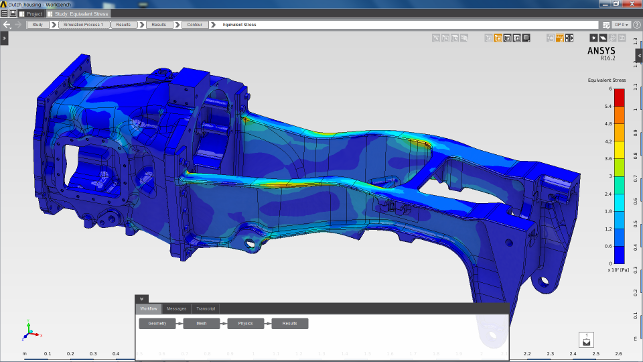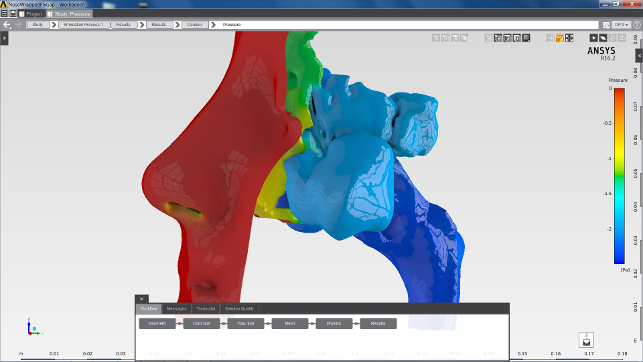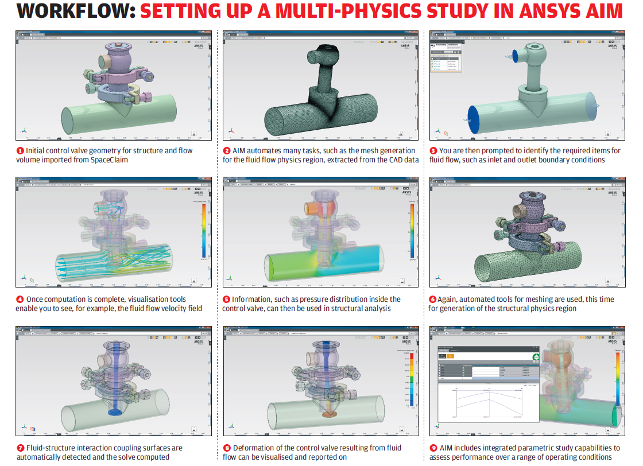Ansys AIM 16.1 is a brand new, next generation mainstream simulation tool. Al Dean is impressed by its new take on solving the challenges of multiphysics simulation and bringing it to a wider audience
Vendors in the analysis and simulation market have been calling multiphysics the ‘next big thing’ for some time now — and from a theoretical standpoint, that makes sense. Why wouldn’t you want to simulate structural, thermal and fluid interactions in a single system?

Fig.1 After running a template, you’re guided through the simulation process (as shown in the workflow panel at the bottom of the UI)
Real-life products, after all, are subject to stresses exerted on them by multiple different physics models.
The issue has been that, for each of the key physics models, dramatically different approaches are required. That’s why you have FEA systems for structural analysis and CFD systems for simulating fluid and thermal effects.
This has been compounded by the fact that vendors have typically focused on a single area of physics — or at least they did until relatively recently.
In the last few years, however, we’ve seen the consolidation of the simulation industry, as vendors have branched out into new areas.
Ansys has been at the forefront of this movement. Having mastered structural FEA-based simulation in its eponymous Ansys product, it then embarked on a series of acquisitions that brought some of
leading names in CFD simulation into the fold, including CFX (acquired in 2003) and Fluent (2006).
At the same time, the company has also been fleshing out its portfolio in other areas, from composites and systems-based engineering, to more specialist code for internal combustion simulation (with its 2014 purchase of Reaction Design) and in-flight icing for the aviation industry (with this year’s Newmerical Technologies acquisition).
Finally, Ansys has also been building out its Workbench product, which provides a single point of entry and connection to a range of solver codes. This gives you a single venue in which to build up geometries, create meshes and pass data between different solver codes.
But while the Workbench interface was clean and consistent, the user still needed to have a decent level of understanding of the intricacies of each solver to get it all to work together. When it comes to performing multiphysics studies, that’s essential — but it’s also a royal pain in the backside, particularly for customers looking to expand the use of simulation in their design and engineering teams.
More systems to learn also means more investment in training, more workarounds to figure out and more integration hassles with which to contend when it comes to connecting systems up.
In other words, Workbench has been a step in the right direction, but it hasn’t gone far enough to make multiphysics truly accessible to a broad swathe of customers.
AIM 16.1 – Consolidated interface
It’s against this backdrop that Ansys AIM 16.1 makes its impressive debut.
While it’s flagged as the AIM 16 release, that’s purely to bring it in line with Ansys’ release naming conventions. But make no mistake: this is an entirely new system.

Fig. 2 AIM clearly flags up the inputs required to set up a fluid flow job
The big picture is that this is the next generation of Workbench, with a laser precision focus on delivering multiphysics simulation within a single, integrated environment to anyone who needs it, but specifically designers and engineers. So let’s take a look through the new release and see what’s been accomplished.
AIM 16.1 – A new user experience
The first thing to know about Ansys AIM is that the development team behind it has taken a very different approach to the user interface and how the user interacts with the system than that seen in Workbench and many of the other Ansys products.

Fig. 3 A bus bar electrical potential simulation
The goal with AIM is to provide a single interface through which you drive the whole process. It’s also designed to be highly template- and workflow-driven, for reasons we’ll get to shortly.
When you open up the system, you’ll notice that there are a few pre-defined templates in the panel to the left of the UI. These give you fast entry into common processes or study types, including structural analysis, fluid flows simulation, thermal analysis, electric condition and fluid structure interaction.
Each of these templates provides a pre-defined workflow, guiding you through the process.
In this release, the starting point is the import of your geometry. At present, AIM doesn’t have any geometry creation or editing tools, but with Ansys’ recent acquisition of SpaceClaim, I’d put money on some of those tools — engineered to provide simulation pre-processing — making their way into AIM at some point soon.
Once your geometry is in place, you then work through the appropriate tasks.
At the bottom of the screen, you’ll see the task panel. This gives you a workflow-style chart showing the constituent steps in the study you’re trying to complete.
As you work through the tasks, you’re prompted for the information you need to supply and given the option to add further information, input and controls. Figure 2 shows the inputs panel for a fluid flow task.
You can see that the minimum inputs are detailed here and it’s made clear if you’ve either missed something or the set-up is otherwise incomplete.
For example, when it comes to dealing with geometry for internal fluid flowbased studies, you need to define the internal volumes.
You then move onto the meshing tasks. Again, the system can handle much of the donkey work for you, based on your previous inputs.
As you’ve already defined the fluid region, it knows what type of mesh you need to have in place in order to complete the study.
When everything is in place, you’ll then be able to compute the study and use the built-in inspection tools to visualise and report on the results. As you’d expect, this is pretty comprehensive and you’ve got Ansys’ wealth of knowledge and experience to guarantee that these tools are top notch.

Fig.4 An exhaust header thermal stress study. Note the more complex workflow at the bottom of the UI
When it comes to more structural jobs, you follow similar processes, but tailored (in terms of inputs, outputs and mesh requirements) for a structural analysis study.
AIM – Enabling multi-physics
While so far we’ve discussed the use of AIM to conduct single-physics studies, the system has been built from the ground up to support the interaction between multiple physics in a single job.

Fig. 5 Biomedical scan data used to study pressure distribution in a nasal cavity
While the use case is pretty much the same, it’s worth following the process through to learn a little more about what’s involved.
Essentially, you begin with the first physics model; in our workflow example on the opposite page, we’re conducting an analysis of a valve and have started with fluid flow.
As previously detailed, you pick the workflow or template you want (in this case, single-direction multiphysics) and the system guides you through it. Here, the fluid flow set-up is pretty simple. Then, when the results are complete, the system guides you into the process of taking those results as the basis for setting up the structural simulation.
It’s at this point that a more traditional multiphysics approach would involve multiple software packages and hours of work to set up the transfer of results from the fluid-flow simulation, define how that maps onto the structural mesh and then fine-tune things to get them to solve.
With AIM, you’ve got pre-baked workflows to handle these tasks and control over all of the different solver technologies involved, making the process pretty simple.

Fig. 6 Exterior flow simulation
The system is aware of where the results are, how to map them (by automatically finding the key coupling surfaces) and then how to feed them into the structural analysis.
Conclusion
The work that Ansys has done with AIM, in this first release, is outstanding.
The ability to rip through a simulation study (and not just in simple use-cases either) will give the system huge value and appeal to a much wider spread of the design and engineering industry.
What’s most interesting, however, is how Ansys is delivering that efficiency, with easy-to-use templates for conducting a wide range of analysis and simulation tasks, but ones that have access to all manner of complex physics models from the very start.
Because of that, Ansys AIM 16.1 has the potential to cure a lot of the headaches involved in connecting up very different methods of simulation, leading users to a greater understanding, far faster, of how a product performs under different stresses.
The template-driven approach will doubtless be expanded with each release.
Right now, it gives you some of the basics, then teases you with single-direction multiphysics, but I expect to see more sophisticated capabilities in each new release.
There’s also the possibility of a more customised, specialised approach for those companies with the internal expertise to develop their own templates, define their own workflows and roll those out to their engineering teams.
The fact that the system is built on top of Workbench, with its breathtaking speed and proven control over all of Ansys’ solver technologies, means that there is plenty of scope for expansion as new tools are brought into the environment.
I’ll be honest: this is one of the most exciting developments I’ve seen in the simulation space for a good long while and I’m eager to see how it develops in future.
It won’t be cheap, but you’ll get a great deal more ‘bang for your buck’ than you would with many of the CADintegrated simulation options. In any case, multiphysics has never been a low-cost business for companies previously forced to buy multiple packages and invest in training to master them all. Ansys AIM changes this.
| Product | Ansys AIM 16.1 |
|---|---|
| Company name | Ansys |
| Price | on application |







